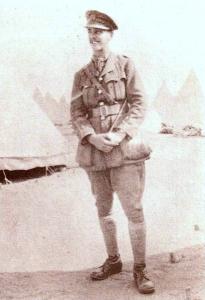
|

|
| 2nd Lieutenant Reginald Cuthbert CHILVERS | |
|
10th (Service) Battalion Norfolk Regiment attached to the 1/4th Battalion Date of birth: 16th December 1898 Date of death: 19th April 1917 Killed in action aged 18 Commemorated on the Jerusalem Memorial Panels 12 to 15 |

|
| Reginald Cuthbert Chilvers was born at "St Olafs", Albany Park, Kingston-upon-Thames in Surrey on the 16th of December 1898 the third son of John Holgate Chilvers, a wine and tea merchant, and Matilda Beatrice (nee Wright) Chilvers of "The Gables", St John's Road Orpington in Kent. He was christened at St Luke’s Church, Kingston on the 15th of March 1899. He was educated at Shrewsbury House Preparatory School, Surbiton and at Lancing College where he was in News House from May 1911 and in Fields House from September 1912 until December 1912. He was a member of the Officer Training Corps. On the 5th of November 1914 he enlisted at 10 Stone Buildings, Lincoln's Inn, London WC as Private A/2024 in the Inns of Court Officers Training Corps. At his medical examination, which was held on the same day, it was recorded that he was 5 Feet 9 3/4 inches tall. He trained with them at Berkhamsted in Hertfordshire before applying for a commission on the 7th of March 1915. He was commissioned as a 2nd Lieutenant in the 10th Battalion Norfolk Regiment on the 26th of March 1915. He proceeded to Egypt and his parents received a telegram shortly afterwards dated the 11th of February 1916;- "2nd Lt R.C. Chilvers admitted to 19 General Hospital Alexandria 8/2/16. Complaint not then diagnosed. Condition good. Further news when rec'd." In a further telegram dated the 26th of February 1916:- "2/Lieut. R.C. Chilvers now reported discharged to duty Feb 13th" On the 29th of February 1916 he was attached to the 1/4th Battalion of his regiment, joining them in camp the same day at Mena near Cairo where they were training new drafts and re-equipping following their time at Gallipoli. The battalion was then sent to guard the Suez Canal where they stayed until June and continued training as well as providing guards for the Suez defence line. In June and July they were at Serapeum and at El Ferdan to the north of Ismailia where they supplied guards and carried out fatigues. On the 29th of March 1916 he was transferred to the Officers Depot at Sidi-Bishir but on the 5th of April he was admitted to 17 General Hospital with diarrhoea, stating there until the 17th of April. On the 19th of April he returned to the battalion at Shalufa. From the 1st of October to the 21st of October 1916 he attended a Stokes Mortar course which he failed and from the 29th of October to the 19th of November he attended an officers course which he passed. In February 1917 the battalion were ordered to march across the desert to assist in the planned attack on the Turks in Palestine. On the 17th of January 1917 he reported to No.1 Depot CTC in Cairo and on the 10th of April he rejoined the battalion in the field at Seirat. On the 17th of April 1917 the 1/4th Battalion Norfolk Regiment were in support of an attack on the Sheikh Abbas Ridge near Gaza. The position was successfully taken and the Turkish defenders driven out. The night of the 17th/18th and the whole of the 18th was spent in these positions before orders were issued late on the 18th for the capture of Gaza and the formation of a new line behind the town. The orders did not arrive until midnight leaving very little time for the officers and men of the battalion to get properly organised. The orders called for the 163rd Brigade, of which the 1/4th Norfolks were part, to attack at Khirbet-el-Bir with the battalion to be on the left of the attack and with the support of a tank. At 5.30 am on the 19th of April 1917 the British artillery opened fire on the Turkish positions which were some 1,700 yards in front of the British front line. They fired for two hours and received little or no return fire from the Turks. At 7.30 am the Norfolks began their advance; Captain Buxton wrote:- "It was a magnificent sight to see them going in extended order as if on a field day". It soon became clear that the artillery had done little damage to the Turkish defences as the battalion walked into " a perfect hell of artillery and machine gun fire." The British artillery was unable to lend significant further support as they had run low on ammunition during their earlier bombardment. The lone tank which moved forward with the battalion was hit by a Turkish shell early in the advance and was put out of action. With casualties mounting the surviving officers decided at 9am to dig in where they were. Despite a counterattack by other battalions at 2.23 pm, no further gains were made and the battalion held its new line until relieved at daybreak on the 20th when the survivors retired to the line they had started from the previous day. The battalion suffered losses of 6 officers and 49 other ranks killed, 11 officers and 312 other ranks wounded with 1 officer and 99 other ranks missing, a total of 477 casualties. Reginald Chilvers was the missing officer. His father applied for his medals in February 1922. He is commemorated on the war memorial at Shrewsbury House Preparatory School. |
|
| Fields House |
Back